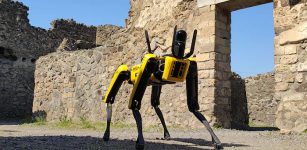Mysterious Chultuns – Ancient Underground Chambers Built By The Maya – But For What Purpose?
Ellen Lloyd - AncientPages.com - The ancient Maya of the Yucatán Peninsula constructed several underground chambers known as Chultuns.
The purpose of the chultuns is still an enigma. It’s not entirely clear for what purpose the pre-Columbian Maya took the time and effort to build these underground chambers.
Suggestions which have been proposed include their use as water cisterns, burial chambers, sweat baths, food cellars, underground religious shrines, and even some form of outdoor plumbing.
Chultuns Were Not Only Used For Water Storage
Most chultuns were bottle-shaped underground storage chambers, carved out of the relatively soft limestone bedrock. They were often plastered with a thick coating of lime stucco.
Archaeologists have discovered that most chultuns were constructed in places where canotes were absent.
Canotes are sinkholes resulting from the collapse of limestone bedrock that exposes groundwater underneath. Especially associated with the Yucatán Peninsula of Mexico, cenotes were sometimes used by the ancient Maya for sacrificial offerings.
Chultuns were often bottle-shaped.
Chultuns were rather common in southern Mesoamerica and they were most likely used to store rainwater. Many chultuns have been looted by thieves looking for valuable artifacts. The fact that the Maya still use these chambers for disposing waste makes archaeological examinations of the chultuns very difficult.
In addition, nor has any series of artifacts been found in chultuns that might provide clear-cut evidence for a simple answer.
Puleston’s Investigations Of Chultuns Reveal A Surprise
The presence of the stone covering lids points to the probability that whatever went on inside the chultuns required that they be kept closed. If the function of chultuns was the storage of food, the primary use of these lids would have been to keep out rain and possibly vermin. What sort of foods might have been stored in chultuns by the Maya?
In the 1960s, Dennis E. Puleston 1940-1978), American archaeologist and ecologist whose work ranged from experiments in reconstruction and usefulness testing of chultuns.
Archaeologists exploring a Chultun (underground cistern) of the Ancient Maya. Image credit: David R. Hixson
Puleston’s studies of chultuns revealed that despite their common name, there were different types of these man-made underground holes. In time, Puleston became convinced that chultuns were used for a variety of purposes. Some of the chultuns which were single chambers with plastered walls were constructed for water storage. However, Puleston noticed that the chultuns in the Tikal region were different in shape, not plastered, and did not hold water.
When Puleston filled a chultun with water and watched it drain away quickly. This lent credibility to his assertion that chultuns of this region were not for water storage.
After many weeks of study, Puleston noticed that the chultun offered valuable protection from vermin. Nevertheless, the underground chambers could not be used for the storage of maize, beans, or squash because these food items were consumed by insects and rodents.
There was no reason to suspect the chultuns were burial chambers. So, why did the Maya construct these enigmatic subterranean holes?
It's very unusual that artifacts are found inside a chultun. In Chultun 3F-6, ancient vessels were discovered. These turned out to be the only examples of this type yet found in Tikal. Image credit: Penn Museum
Puleston had no intentions of giving up. Determined to unravel the mystery of the chultuns, he took some nuts from a local tree and placed them in the storage chamber. Then, he waited. When he returned to the chultun 13 weeks later, he discovered the ramon nuts, not only had survived, but they were still in excellent condition and completely edible.
There are many advantages of using an underground storage system. Puleston’s discovery revealed that the ancient Maya realized some of the underground chambers were particularly effective for long-term storage of ramon nuts.
Written by - Ellen Lloyd – AncientPages.com
Copyright © AncientPages.com All rights reserved. This material may not be published, broadcast, rewritten or redistributed in whole or part without the express written permission of AncientPages.com
More From Ancient Pages
-
 Meet SPOT – Robot Dog Deployed To Guard The Ancient Ruins Of Pompeii
News | Apr 1, 2022
Meet SPOT – Robot Dog Deployed To Guard The Ancient Ruins Of Pompeii
News | Apr 1, 2022 -
 Ancient Mystery Of The Oghars – An Unusual And Little-Known Lost Race
Ancient Mysteries | Mar 19, 2019
Ancient Mystery Of The Oghars – An Unusual And Little-Known Lost Race
Ancient Mysteries | Mar 19, 2019 -
 1,800-Year-Old Villa Of Famous Ancient Fisherman Phainos Unearthed In Turkey
Archaeology | Jun 20, 2018
1,800-Year-Old Villa Of Famous Ancient Fisherman Phainos Unearthed In Turkey
Archaeology | Jun 20, 2018 -
 Does Celtic Art Have Links With Iron Age Art Of The Eurasian Steppes?
Archaeology | Oct 15, 2015
Does Celtic Art Have Links With Iron Age Art Of The Eurasian Steppes?
Archaeology | Oct 15, 2015 -
 First Early Roman Fortlet Found On The Isle of Anglesey, North Wales
Archaeology | Nov 26, 2015
First Early Roman Fortlet Found On The Isle of Anglesey, North Wales
Archaeology | Nov 26, 2015 -
 Reconstructing The Lost Ancient World Of The Marquesas Islands With Unique Plants And Animals
News | Mar 31, 2022
Reconstructing The Lost Ancient World Of The Marquesas Islands With Unique Plants And Animals
News | Mar 31, 2022 -
 Riddle Of An Ancient Underground City No-One Thinks Exist – Symbol For A Spiritual Quest – Part 2
Ancient Mysteries | Sep 18, 2019
Riddle Of An Ancient Underground City No-One Thinks Exist – Symbol For A Spiritual Quest – Part 2
Ancient Mysteries | Sep 18, 2019 -
 On This Day In History: Fascinating Prague Astronomical Clock Mentioned For The First Time – On Oct 9, 1410
News | Oct 9, 2016
On This Day In History: Fascinating Prague Astronomical Clock Mentioned For The First Time – On Oct 9, 1410
News | Oct 9, 2016 -
 Medicine in Antiquity: From Ancient Temples To Roman Logistics
Archaeology | Apr 13, 2018
Medicine in Antiquity: From Ancient Temples To Roman Logistics
Archaeology | Apr 13, 2018 -
 Mysterious Biblical Canaanites – What Ancient DNA Reveals About Their Fate
Archaeology | Jul 28, 2017
Mysterious Biblical Canaanites – What Ancient DNA Reveals About Their Fate
Archaeology | Jul 28, 2017 -
 Epi-Olmec: Undeciphered Isthmian Script Of Mesoamerica
Artifacts | Mar 13, 2016
Epi-Olmec: Undeciphered Isthmian Script Of Mesoamerica
Artifacts | Mar 13, 2016 -
 First Scandinavian farmers were far more advanced than previously thought
News | Aug 23, 2015
First Scandinavian farmers were far more advanced than previously thought
News | Aug 23, 2015 -
 First Humans Appeared In Europe 1.4 Million Years Ago – Stone Tools Found At Korolevo Reveal
Human Beginnings | Mar 8, 2024
First Humans Appeared In Europe 1.4 Million Years Ago – Stone Tools Found At Korolevo Reveal
Human Beginnings | Mar 8, 2024 -
 Quatrefoil Symbol Was Used By The Olmecs And Maya Long Before It Appeared On Christians Churches
Ancient Symbols | Mar 19, 2018
Quatrefoil Symbol Was Used By The Olmecs And Maya Long Before It Appeared On Christians Churches
Ancient Symbols | Mar 19, 2018 -
 Ancient DNA Reveals Bronze Age Women Altered Genetic Landscape Of Orkney
Archaeology | Feb 7, 2022
Ancient DNA Reveals Bronze Age Women Altered Genetic Landscape Of Orkney
Archaeology | Feb 7, 2022 -
 Mysteries Of The Huldufolk – The Hidden People Of Iceland
Featured Stories | Feb 1, 2022
Mysteries Of The Huldufolk – The Hidden People Of Iceland
Featured Stories | Feb 1, 2022 -
 Australia’s First Marine Aboriginal Archaeological Site Questioned
Archaeology | Jun 22, 2022
Australia’s First Marine Aboriginal Archaeological Site Questioned
Archaeology | Jun 22, 2022 -
 DNA Confirms 2,000-Year-Old Sustainable Fishing Practices Of Tsleil-Waututh Nation
Archaeology | Nov 13, 2021
DNA Confirms 2,000-Year-Old Sustainable Fishing Practices Of Tsleil-Waututh Nation
Archaeology | Nov 13, 2021 -
 Likho (Licho): Puzzling And Persistent Demon Of Mischief In Slavic Mythology
Featured Stories | Dec 18, 2016
Likho (Licho): Puzzling And Persistent Demon Of Mischief In Slavic Mythology
Featured Stories | Dec 18, 2016 -
 Mystery Of The Faceless Creature – Ancient And Modern Sightings
Ancient Mysteries | Jun 19, 2018
Mystery Of The Faceless Creature – Ancient And Modern Sightings
Ancient Mysteries | Jun 19, 2018




